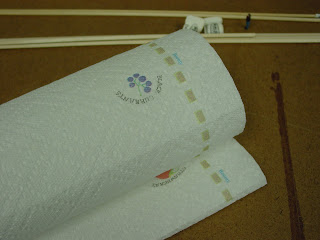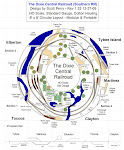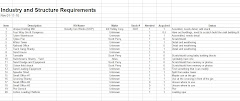
Painting is the first chore this afternoon. I need to paint the pier base. There is always a pile of newspapers handy so I'll paint inside today against my better judgement.
I spread the papers out on the work table.
First, I double check the fit and fitness of the section and the base. Still a perfect fit.
Using a box cutter I trim off the dangerous toothpicks that I used to fill the gap. The connection is very strong here.
Using a coarse grit sanding sponge I give the entire base a once over.
There were some glue spots on the bottom so I used the box cutter and the sanding sponge to remove them and make the wood nice and smooth.
There! Ready to paint. We'll do the bottom first. You wouldn't need to do this. I'm only doing it because this section will be removed and photographed for a clinic when done.
The first light coat of flat black spray paint goes on. Appears I didn't put down enough paper.
While that dries, let's go check our supply of lumber. I'll need plenty of 1/8" dowels and 1/8" x 1/8" square lumber. Usually I have some of everything in this box, so I pull out everything I could find.
Using my scale I check the dimensions of the so called 1/8" sqaure stick. Perfect! Sometimes it changes sizes in storage.
Because I work in several scales I always keep a scale foreman around. This is HO Fonzi. He is here to make sure I don't drift off into O or N land.
Fonzi sits on the work bench and watches.
With our collection of lumber I can see that I am short of both of the sizes I need. For the decking I don't have any 2" x 12" boards, but I have a ton of 2" x 9" planks from a project I didn't finish. That means we'll change the planks to what I have.
I had to empty the trash and the dust and crud in the trashcan was horrible. So I cleaned it out and put in a trash can liner this time. A Glad liner. Made by the Clorox company.
I flipped the base over when it dried...and...
...gave it another coat of paint on the top.
Ok, back to the shop. I'm going to make some experiments to see which way I want to build the pier. Most of the models of piers I've seen are brown, but I've NEVER seen one in real life that wasn't a weathered grey. So grey it will be. I keep a box full of shoe dye so we'll start there.
A bottle of rubbing alcohol. You can use IPA, Isopropyl, etc...it all works fine. Just don't use the rubbing alcohol with wintergreen or color in it. Basically for me...the cheaper the better.
You'll need some rags. These are da bomb! They are surgical cloths that my friend at a hospital gives me. They are completely lint free and very sturdy! Yet, they wash them and throw them away. I get them by the bag full.
A number 8 horse hair brush with a rounded tip.
A pair of precision stainless steel tweezers.
A plastic tray for drying purposes.
Lots of paper towels. Go get them now, not after a spill!
A glass work surface.
A hobby knife with a fresh, high quality blade. This knife has a padded handle and a hex-nut type top that keeps it from rolling off the table. Keeps it from landing on your foot (experience!)
Next, is entertainment! First we'll enjoy some Clint Eastwood in a spaghetti western. Then we'll listen to Allen Keller interview John Armstrong.
A used cutting blade for scoring.
A sanding sponge, fine grit.
And the test begins. First we'll score some of the square wood with the old saw blade and give it a light sanding to remove the fuzz. Then we'll cut it into three small pieces.
Using this super handy stainless steel sauce cup is an excellent tool to have around. I got this one from a restaurant manager. It has the perfect pitch on the sides, and is stainless so that it cleans up easily. Since it is rather heavy it doesn't move on the table. I have several and would like some more. We'll put about a 1/2 oz of alcohol in there for the dye.
Using a disposable pipepette dropper, I take a few drops of dye and put it in the alcohol, then give it a good stirring.
Latex or nitrile gloves are MANDATORY when working with shoe dye. You will have black spots on your hands the next day if you don't.
I'll mix the black dye and apply it to the boards with the brush. After each board I'll darken it with another drop or two. This technique did NOT look good and didn't give me what I wanted. We'll try something else.
Let's grab the trusty Dr. Ben's Weathering Stains box! I love this stuff and have invested in quite a collection. The colors are fantastic and they really work well. This is an 8 pack of key stain colors. We'll get out the driftwood bottle.
Time to paint some more. Cough Cough. I haven't even sprayed that much and the fumes are bad. Ok, last time to paint in the basement.
This is a new bottle, so I broke the seal after a good shake and wet the brush with some alcohol.
The driftwood looks good! I also took some Dr. Ben's Weathering Powder Aged Black and added a little "gray" to the board. Perfect! It gave me the lighter, washout out gray that I wanted. I'll need some short boards for the top of the pier and for the small sides, so I painted several strips of square board and then set up my chop saw to cut 10' sections.
Here they are. Not too dark, gray but still like wood.
Here is the Weathered Black pigment. One jar of this might last you a lifetime. It's over $6 for a jar, but when you consider that you can buy 3 or 4 jars of Floquil and have it clog/dry up/spill, this is a bargain. A little goes a LONG WAY. I have a big set of these with about 36 colors.
There! All painted. I moved it in the to heated shop to dry a little faster as I'd like to get started on it tonight.
A quick trip to the hobby shop got me some more dowels. They ordered me a bunch of square sticks but I needed a few for today so I bought 11 at Hobby Lobby. That will get the base covered anyway. The Midwest lumber will be here Friday, weather permitting.
The first thing is to cut all the tags off the 1/8" x 1/8" squares. What a pain!
Next, I'll line them all up (10 sticks) and score them all at once with the saw, then lightly sand.
Here they are with one coat (on one side only - the saw distressed side) of Aged Driftwood and a light dry brushing/wash of Weathered Black pigment and alcohol. Looks perfect! I laid the sticks under a heavy sheet of glass to keep them from warping. I also distressed, sanded, Driftwooded and blackened some dowels.
A test fit shows the coloring and size to be very good for what I'm looking for. Keep in mind that is may look a little light to you, but the camera lighting is bad and there will be MORE weathering and detail added. The vast majority of models I've seen are too dard (mine too) and I'm trying to lighten up. The NCI guys will tell you that this is impossible. We'll let everything dry as I go make dinner for the family. Be back later!
Time passes....tick tick tick
And now, it's 10:30 pm est.
I've taken up eating Trader Joe's Organic Animal Crackers. They taste good. They are crunchy. Low fat, low sugar, low cholestrol. The main thing I like about them is that they are cheap and don't go stale in the basement. These cookies will last forever. They also go good with Bourbon.
In case you don't know there is a BIG difference between school glue and Elmer's Glue All. School glue (including Elmer's School Glue) is water soluable after it dries. You won't know the difference until you hit your scene with artificial water or water/alcohol washes and then all of your parts fall apart. So only use the Glue All or equivalent. We'll be using it to put together the walls.
This looks a bit sloppy and is intended to be so. The first board around the bottom won't be seen as it will be under water. It DOES have to be waterproof and the heavy glue is designed to provide one more seal around the edge of the base to hold in the "water". I put one 1/8" x 1/8" distressed board along the whole ocean retaining wall.
This board is in an odd place and the one I picked had a bit of a curve to it so it didn't want to hold in place. I used clamps and my ever ready supply of popsicle sticks (see Rick, it's catching!) and made a push clamp to hold the board in place while the glue dried.
I reset the angle on the chop saw for the small angled part of the wall and began chopping the small boards that I made first.
Board by board they creep up the wall being carefull not to let the glue creep through the boards. I'll trim off the excess later.
Here is the finished side wall. The colors are perfect. I put a small section of the piling in front and it is going to look great. The boarding is going faster than I thought. There is a small bead of glue on the backside of the overhang of boards that will help hold them together when I hit them with a Dremel saw.
There is going to be a LOT of time invested in this so I might leave it for a day or two and come back to it as I get board with planking. Or is that bored? I can do about 1 hour at a time of a repetive job before I get sloppy. I'm about out of boards anyway and will have to wait until my shipment comes in from Trainmaster on Friday.
Night!





























































tell me more about that chop saw you use. It looks neat and I just might need to get one myself. thanks.
ReplyDelete